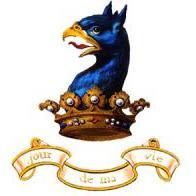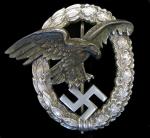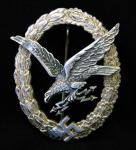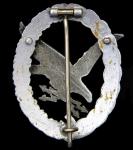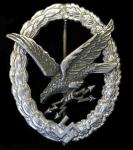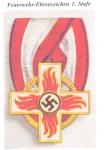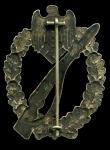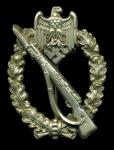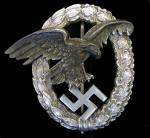-
Posts
3,397 -
Joined
-
Last visited
-
Days Won
3
Content Type
Profiles
Forums
Blogs
Gallery
Events
Store
Everything posted by J Temple-West
-
Mary anne Ok?.. reading?.blah blah blah?G?ring?blah blah?presentation. Right? just trying to find out if we have a location for this dagger, but can?t find anything in any of the reference works on edged weapons. Anyway, the term most commonly used when describing this dagger is ?One of a kind?. The reason being is that the original dagger was produced by the industrial leaders of Solingen and presented to ?Reichsmarshall Hermann G?ring?. The dagger features a genuine ivory grip and a 10 inch blade made of Damascus steel. The reverse ricasso of the blade bears the raised gold inscription ?Echt Damast P. Mueller? (True Damascus P.Mueller)?Paul Mueller being one of the top blade makers in Solingen. Unfortunately, as with most TR pieces, this dagger has been copied, and aside from the fact that the original piece would have to be classed one of the rarest, this piece of yours has ?Paul Weyersberg & Co Berlin? stamped into the blade, a sure sign of it being a fake as the firm ?Weyersberg? were based in Solingen, not Berlin. I wish I had better news for you.
-
A lot of makers used the same hinge/pin style on their zincers, they even used similar flat wire catches... but I've never seen an Assmann with an oblong catch plate. Do I detect that you may have something to show us, Jan? A quick pic of hinge/hinge plate set-ups from Assmann (left) Eric's Juncker (middle) and Osang (right).
-
The rectangular catch plate was used by most makers on their zinc badges. The hinge (the closest I can get to is by Assmann, and the hinges found on their tombak/buntmetal badges) doesn't match any that I know of on any zinc Luftwaffe pieces...then, of course, this isn't a TR Luftwaffe badge is it? I'm intrigued?what badge is it?
-
Cheers, D You could well be right. Have just had a good look at my case (first time in years) and there seems to be the smallest traces of silver in the indented lines, or is it just dust! Looking?.wiping?You are right! So, the paragraph should read?.. The case, if original to the cross, should have, as mentioned by Chris, a gold line around the top of the lid. If no gold line is found then the case is for a 2nd class cross and has, at some point, been swapped. Apologies for the confusion.
-
Designed by Herbert Kn?tel ? Berlin, the 1st/2nd class Fire Brigade Decoration (Feuerwehr Ehrenzeichen) was instituted on the 22nd December 1936. The award took the form of the cross shown above. The 1st/2nd class cross were identical in design, except for a difference in size, the 1st class being slightly larger, and having a pin-back set-up. The metal parts, on both badges, were finished in nickel silver plate. On the 30th January 1938, a change to the Fire Brigade decoration took place and the pin-back version was replaced with an identical cross to the 2nd class but with all the metal parts finished in gold plate. So, what you have there is the post 1938 1st class Fire Brigade Cross, and a very nice example it is too. The case, if original to the cross, should have, as mentioned by Chris, a gold line around the top of the lid. If a silver line is found then the case is for a 2nd class cross and has, at some point, been swapped. For reference, a couple of examples of the 2nd class with all silver metal parts. Sorry for the poor photos?they were taken many moons ago.
-
An interesting question, Jon Having read a couple of biographies on Hans-Joachim Marseille, the observer badge is never mentioned. Of course, completion of the course for observer was not a prerequisite for the ?Combined Pilot/Observer Badge in Gold with Diamonds?. If it were, very few of the actual recipients would have been eligible. Awards: 1 February 1940 - Flugzeugf?hrerabzeichen (Pilots Badge) 9 September 1940 - Iron Cross Second Class for two air victories. 17 September 1940 - Iron Cross First Class for fourth air victory. 3 November 1941 ? Luftwaffe Goblet of Honour (Ehrenpokal f?r Besondere Leistung im Luftkrieg) 24 November 1941 - German Cross in Gold 22 February 1942 - Knight's Cross for reaching 46 kills. 6 June 1942 - Oak Leaves to the Knight's Cross for 75 kills. 18 June 1942 - Swords to the Knight's cross with Oak Leaves for 100 kills (presented by Hitler on 28 June 1942 in the F?hrerhauptquartier Wolfsschanze in Rastenburg). August 1942 -Awarded Golden Pilot's Cross with Diamonds (presented by Reichsmarshall Hermann G?ring). 6 August 1942 - Awarded highest Italian decoration for bravery, the Medaglia d'Oro, (presented by Benito Mussolini in Rome on 13 August). 2 September 1942 - Becomes only the fourth German serviceman to be awarded the Diamonds to the Knight's Cross with Oak Leaves and Swords. The Diamonds were to be made in a special, by Adolf Hitler defined, fashion. Hitler had decided to present them to Marseille personally some time later in the year. However, Marseille's death prevented this. It is unclear why the Diamonds were never handed out to Marseille's family after his demise, as foreseen by Reichsgesetzblatt I S. 1573 Article 7 (German Law of 1939 enacting the Knight's Cross). 7 June 1943 - Africa Cuff title (posthumously)
-
Hi Ferg1 There is a lot of hard evidence to prove the collaboration between the two firms. Whether Juncker bought out the firm of W. Deumer or just supplied them with parts is unknown, but the badge below tells the story. Observer badge marked ? W. Deumer ? L?denscheid? Wreath and eagle produced by ?CE. Juncker ? Berlin? Construction (hinge-pin-catch-rivets) and finish by Deumer.
-
Hi Jonathan... Even without seeing the reverse, I think we can safely say that it's a zinc piece due to the non cut-out swastika. The reverse should show the hinge and catch mounted on to plates for better adhesion to the wreath. Here?s a side-by-side comparison of buntmetal (left) and zinc (right) badges. Obverse.



